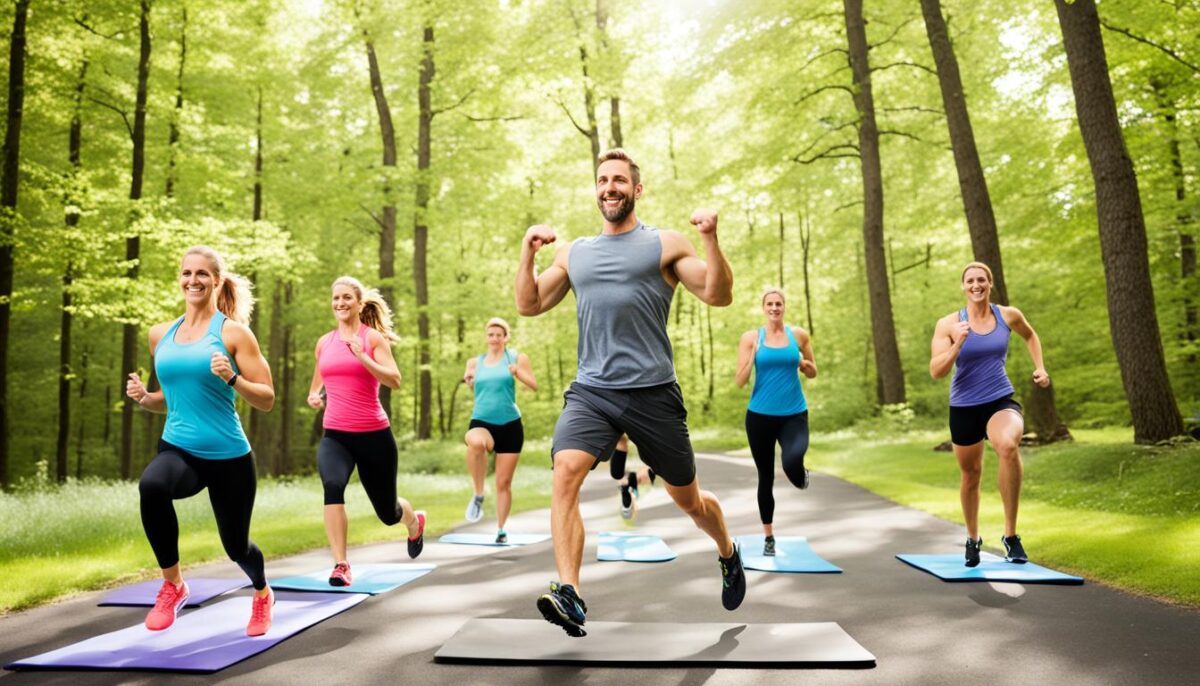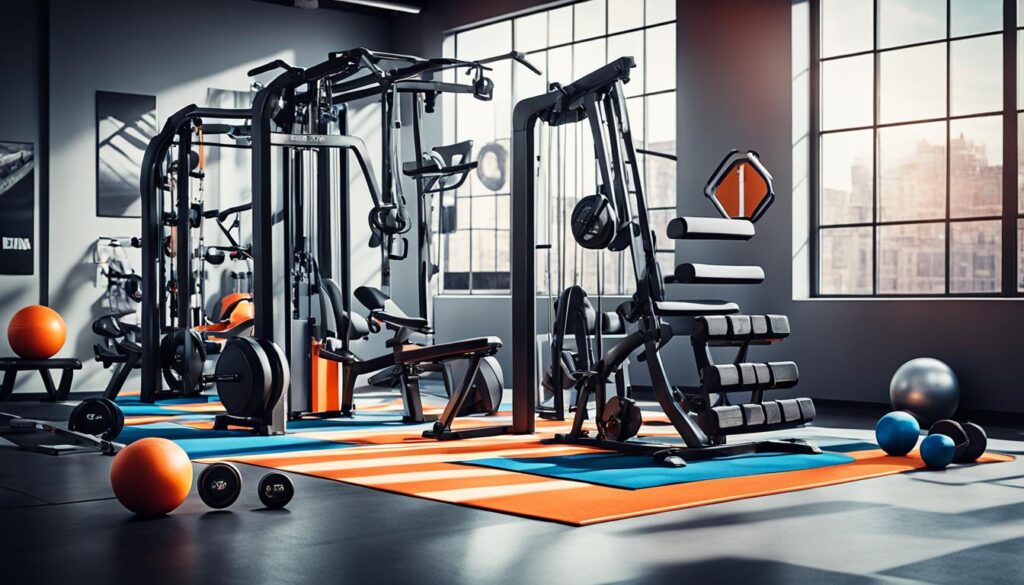Do you feel sluggish and want to make a change for better health? The key could be the right workout routine. With many choices, it’s hard to know what’s best. This article explores effective fitness plans. We look at strategies to help you build muscle, lose weight, or boost your stamina.
There’s no single best way to train. For best results, your routine should mix aerobic fitness, strength training, core exercises, balance training, and flexibility and stretching.1 These five areas together form a solid fitness plan. They support your health and well-being all-around.
Aerobic exercises like walking, jogging, biking, and swimming push your heart and lungs. They make your cardiovascular system stronger.1 Strength training makes your muscles and body stronger. It is key for weight management. Try to do two strength sessions each week, working out all main muscle groups.1
Exercise is more than building muscles. It’s also about staying balanced and flexible. Core exercises like planks help the muscles around your belly, back, and pelvis. They make your posture and movement better.1 Balance training and flexibility and stretching also matter a lot. They can keep you from falling, make your body stable, and lessen stress.1
Key Takeaways
- Fitness training should balance aerobic fitness, strength training, core exercises, balance training, and flexibility and stretching.
- Aerobic activities like walking, jogging, and swimming boost cardiovascular health, while strength training builds muscle and aids in weight management.
- Core exercises, balance training, and flexibility activities are crucial for supporting overall movement, stability, and range of motion.
- Incorporating a variety of exercises that target different muscle groups and fitness elements can contribute to long-term health and wellness.
- Consulting with a fitness professional can help you design a personalized workout routine tailored to your specific goals and fitness level.
Understanding the Importance of Fitness Training
Keeping up with a diverse fitness plan is crucial for a more health-conscious life. It’s key to include aerobic fitness, strength training, core exercises, balance training, and flexibility and stretching in your routine.1
Elements of a Well-Rounded Routine
Aerobic activities like walking, jogging, and swimming are great for your heart, lungs, and blood flow. They make your cardiovascular system stronger.1 Doctors suggest that most adults do 150 minutes of moderate aerobic activity or 75 minutes of intense aerobic activity each week.2 To lose weight or stay fit, try to do at least 300 minutes of aerobics weekly.1
Strength training helps you build and keep muscles, which is good for managing your weight. You should do exercises that work your main muscle groups at least two times weekly.1 This will help you have more lean muscle than fat and make your bones stronger.3
Balancing Aerobic Fitness, Strength Training, Core Exercises, Balance, and Flexibility
Doing core exercises like planks and sit-ups can strengthen your core. This means your abs, lower back, and pelvic muscles will be better, improving your posture and the way you move.1
Balance training is essential, using methods like tai chi to reduce falls and boost stability, especially for the elderly.1 Tai chi and yoga are great to help everyone keep their balance and stay independent.3
Flexibility and stretching make you more limber, help with standing up straight, and lower stress.1 Remember, always stretch after working out, when your muscles are warm. Try to stretch for at least 30 seconds every time.1
Integrating aerobic fitness, strength training, core exercises, balance training, and flexibility and stretching forms a sound foundation for your fitness. It ensures your health and wellbeing are supported.1
Assessing Your Current Fitness Level
https://www.youtube.com/watch?v=42fVGpylH2Y
Starting a fitness program begins with understanding your fitness level. You can measure this by checking your pulse rate after walking or running a mile. Also, see how long it takes you to cover a set distance. Count the number of pushups you are able to do, and check your flexibility.4
Measuring Aerobic and Muscular Fitness
The 12-minute run test tests how far you can run in 12 minutes. This checks how well your body uses oxygen when exercising. It’s useful for estimating your VO2 max. For instance, a 40-year-old woman in top condition could run 1,900 to 2,300 meters in 12 minutes. A man of the same age would need to run 2,100 to 2,500 meters for the same level.5
A test for muscular strength is the pushup test. Results vary by age and gender. For example, a 30-year-old man would be in great shape if he can do 44 pushups. But if he does 12 or fewer pushups, that’s a sign he needs to improve his fitness.5
Evaluating Flexibility and Body Composition
Body composition checks your size and weight in relation to health. It includes waist size and BMI. Understanding these helps in setting and achieving fitness goals. It tracks how well you’re improving your aerobic ability, strength, flexibility, and weight.4
| Fitness Metric | Measurement | Significance |
|---|---|---|
| Resting Heart Rate | 60-100 beats per minute4 | Indicator of cardiovascular health |
| Target Heart Rate Zone | 50-85% of maximum heart rate4 | Optimal range for aerobic exercise |
| 1.5-Mile Run Time | Varies by age and gender4 | Measure of aerobic fitness |
| Pushup Count | Depends on age and sex4 | Indicator of muscular strength |
| Waist Circumference | Women: 35 inches or more, Men: 40 inches or more4 | Risk factor for heart disease and diabetes |
| Body Mass Index (BMI) | Underweight: 2 | General indicator of body composition |
Designing an Effective Fitness Program
Start your fitness journey with clear, realistic fitness goals. These might be losing weight, boosting endurance, or preparing for an event. Having specific goals will shape your workout plan and help you see your progress.6
Setting Realistic Fitness Goals
When creating your fitness program, think about what you can do now. Choose goals that push you but are not too hard. The CDC says adults should do 150 minutes of moderate activity a week, plus two days of muscle work.6 For better health gains, try 300 minutes of moderate aerobic activity weekly.7
Incorporating Variety and Cross-Training
To keep things interesting and avoid injuries, mix up your workouts. Combine cardio, strength, and flexibility exercises.6 High-intensity interval training (HIIT) boosts both endurance and health.7
Scheduling Exercise into Your Daily Routine
Make your workout a regular part of each day. Treat it like an important meeting and increase its length and effort slowly.7 Don’t ramp up your exercise more than 10% per week to prevent injuries and ensure steady improvement.7
Focus on achievable goals, mix up your exercises, and make working out a habit. This way, your fitness plan will support your well-being in the long run. Start with easy steps, check how your body reacts, and make changes as you get healthier.6
Gathering the Right Equipment
Getting the right workout equipment is key, especially the right athletic footwear.7 When starting a fitness program, it’s crucial to pick out good shoes.8 Think about what you’ll be doing. Running shoes differ from those made for cross-training.
Choosing Appropriate Footwear
Choosing the right shoes matters a lot for how you feel and do in activities. Whether you hit the gym or go for a run, good athletic footwear is a must.8 If you’re new, getting advice from pros can stop injuries before they start.
Exploring Exercise Technology and Apps
Using fitness technology like trackers and workout apps can keep you on track and pumped up.7 Apps and trackers help you see your gains and spots you can improve. They make reaching your fitness aims smoother by giving you tips on your workout.
Workout Routines for Different Fitness Goals
To meet your fitness goals, choosing the correct workout is crucial. If you want to gain muscle, lose weight, or boost your energy, a smart mix of exercises is essential.9
Strength Training for Muscle Building
Tackling strength with routines like squats and dumbbell exercises is key for muscle growth.9 It’s best to do this kind of workout two to four times a week for great results.9
Cardio Exercises for Fat Loss
Walking, running, and cycling aren’t just good for the heart. They burn fat and boost your endurance.9 Doing cardio training three to five days weekly is ideal for losing weight and building stamina.9
Endurance Training for Improved Stamina
Hiking, biking, and swimming make your heart stronger and increase your physical power.9 You should try these activities two to three days a week to enhance your stamina.9
For the best results, use a varied approach that suits your goals. Always talk with a pro before starting a new workout. And, remember progress takes time, so stay determined.9108
Maximizing the Benefits of workout routines
To really get the most out of your workout routines, try high-intensity interval training (HIIT). Also, make sure you balance how hard you train with enough time to recover. This mix will help you make the most of your fitness progress and maintain your health.
Incorporating High-Intensity Interval Training (HIIT)
High-Intensity Interval Training (HIIT) mixes short, intense exercise with brief rest. By doing this, you work on your aerobic endurance and boost your metabolic health. It’s great for all fitness levels.
Balancing Intensity and Recovery
Using HIIT is good for your heart, but it’s crucial to mix in less intense activities. This helps avoid overstraining your body and keeps your joints healthy.
Remember, it’s essential to gradually add more HIIT workouts. And always keep your movements under control to prevent injuries. Switch between HIIT and activities like walking or swimming to find a good balance for your body.
Home-Based Workout Routines
Looking for a way to work out at home without a gym membership? Bodyweight exercises are a great option. They include pushups, squats, and lunges. You can do them to boost your strength and cardio level in your living room.11
Bodyweight Exercises for Strength and Cardio
The great thing about bodyweight exercises is how easy and accessible they are. Mix up different exercises to work all your muscles. This helps you make a full home workout that gets you closer to your fitness goals.11
Want to get stronger, last longer, or just stay active? Bodyweight exercises are perfect. There are simple ones, like pushups and squats. And, there are harder ones, like exercises on one leg or jumps. You’ve got lots of options to choose from.11
Modifying Exercises for Limited Space
Don’t have much room at home? You can mix up bodyweight exercises to fit smaller spaces. Instead of regular pushups, try them against a wall. Or use a chair for step-ups to work your legs. These changes help you use less space but still work out well.11
Get creative with your workout spot. Try different ways to exercise. This way, you can keep fit at home, no matter how much space you have.11
To make your home workout really work, do a mix of bodyweight exercises. This hits all your major muscle groups and gives you a solid workout. With some creativity and stick-to-itiveness, you’ll hit your fitness targets from home.11
Staying Motivated and Overcoming Obstacles
Keeping up motivation and tackling hurdles are crucial for a successful fitness journey. Set attainable goals to help stay determined. Even when facing challenges, this approach will keep you focused.12
Setting Achievable Goals and Tracking Progress
It’s important to set clear fitness goals.13 These should be specific but not out of reach. They will help you make progress each week while moving you forward in your fitness story.13 Checking your progress is vital. Use measurements like stamina, strength, and flexibility to see how you’re doing. This approach lets you celebrate improvements as they happen.12
Finding Accountability Partners or Groups
Being part of a supportive group or having a fitness buddy can really boost you.12 Working with others who have similar goals can keep you focused. They offer support and fun in your exercises.12 It’s essential that your partners or group share your vision. This is what will help push you to triumph.13
To overcome barriers and reach your fitness goals, remember to do a few things. Place importance on what you’re doing. Also, make sure your goals are realistic. Keep track of how you’re doing. And lastly, be part of a team that lifts you up. This way, you can beat challenges and reach your fitness dreams. Be steady, rejoice in your victories, and see how staying motivated and disciplined changes everything in your health journey.
Integrating workout routines into a Healthy Lifestyle
It’s key to fit your workout routine into a wider healthy lifestyle. This means looking at your nutrition, handling stress, and taking care of mental well-being.14
Balancing Exercise with Proper Nutrition
Pairing your exercises with a diet rich in nutrients is crucial. This supports your body’s recovery, muscle growth, and energy. Include protein, complex carbohydrates, and healthy fats in your meals. This mix enhances your performance and recovery. With the right fuel, you can work out harder and see better results.
Managing Stress and Promoting Mental Well-being
Fight stress by adding activities like meditation, yoga, or taking breaks to your fitness plan. These help your health and well-being. Mindfulness and relaxing lower stress’ harm, boosting your focus and energy for workouts and daily life.
Fusing your workout with a complete healthy lifestyle brings many physical and mental gains. Better cardiovascular fitness and muscle strength, sounder sleep, and a lift in self-confidence are just some benefits. A balanced health approach promises a more exciting and rewarding life.
Conclusion
Adding a complete workout routines to your life can boost your body and mind. You’ll see better heart health, strong muscles, improved sleep, and more confidence.15 Always start slowly, make goals you can reach, and keep with it every day.16 Doing this will lead you to a fitter, happier life thanks to good workout routines.16
Doing exercises that work lots of muscles can make you stronger overall, help your posture, and cut down on chances of getting hurt.16 Mix it up with different kinds of exercises, like using your own body weight, lifting weights, and doing cardio that really works your body. This way, you’ll create a balanced workout plan that helps you meet your fitness aims.16
Enjoying your workout plan and sticking to it are the secrets to a forever healthy lifestyle. With time, effort, and caring about your health, you’ll see amazing changes from your workout routines. This is your route to a brighter, healthier future.1516
FAQ
What are the key elements of a well-rounded fitness routine?
A strong fitness routine includes aerobic, strength, and flexibility exercises. It also should have core and balance training. These work together to keep you fit and healthy.
How does aerobic activity benefit cardiovascular health?
Activities like walking or swimming make your heart beat faster. They increase your breathing and improve blood flow. This is great for your heart health.
How often should I incorporate strength training into my routine?
Try to strength train twice a week. Work on all your major muscle groups. This will make you stronger.
What are the benefits of core exercises?
Core exercises help your abdomen, lower back, and pelvis. They make your posture and movements better.
How can balance training help prevent falls?
Balance training, like tai chi, is great for not falling. It makes you more stable, especially as you get older.
Why is flexibility important for overall fitness?
Being flexible means you can move your body more easily. It helps lower stress and tension too.
How can I assess my current fitness level?
Check your pulse, timed walks or runs, how many pushups you can do, and how you move. This tells you how fit you are.
What should I consider when setting fitness goals?
Setting specific and realistic goals is key. It might be losing weight or getting better at a sport.
How can I make exercise a consistent part of my routine?
Put exercise on your schedule like it’s an important meeting. This can help you stick to it.
What kind of workout equipment is important to have?
Good shoes are a must. They protect your feet when you work out.
How can strength training help with muscle building and fat loss?
Strength exercises help you gain muscle and become more powerful. And exercises like running or cycling also help you lose fat.
What are the benefits of High-Intensity Interval Training (HIIT)?
HIIT mixes intense workouts with breaks. It boosts your fitness and health, no matter your starting point.
How can I design an effective home workout routine?
Exercises that use just your body, like pushups and lunges, can make you strong and fit. Mix up these exercises to work all your muscles.
How can I stay motivated and overcome obstacles in my workout routine?
Setting clear goals and tracking your progress can keep you motivated. Having a friend or group to work out with helps a lot too.
How can I integrate my workout routine into a healthier lifestyle?
Eating well and reducing stress are important. They help support your exercise and keep you healthy.
Source Links
- https://www.mayoclinic.org/healthy-lifestyle/fitness/in-depth/fitness-training/art-20044792
- https://www.mayoclinic.org/healthy-lifestyle/fitness/in-depth/exercise/art-20048389
- https://www.health.harvard.edu/topics/exercise-and-fitness
- https://www.mayoclinic.org/healthy-lifestyle/fitness/in-depth/fitness/art-20046433
- https://www.verywellfit.com/home-fitness-tests-3120282
- https://www.onepeloton.com/blog/build-a-fitness-routine/
- https://www.mayoclinic.org/healthy-lifestyle/fitness/in-depth/fitness/art-20048269
- https://www.muscleandstrength.com/workout-routines
- https://www.piedmont.org/living-real-change/how-to-create-a-workout-plan-for-your-fitness-goals
- https://www.verywellfit.com/sample-workout-schedule-1230758
- https://www.healthline.com/health/fitness-exercise/at-home-workouts
- https://www.instructorlive.com/helpful-articles/articles-wellbeing/strategies-to-overcome-mental-barriers-and-stay-motivated-in-fitness/
- https://www.blenderbottle.com/blogs/health/8-tips-for-staying-motivated-on-your-fitness-journey
- https://www.helpguide.org/articles/healthy-living/how-to-start-exercising-and-stick-to-it.htm
- https://www.ncbi.nlm.nih.gov/pmc/articles/PMC8372753/
- https://www.linkedin.com/pulse/everyday-fitness-unlocking-power-functional-exercises-amol-patil



